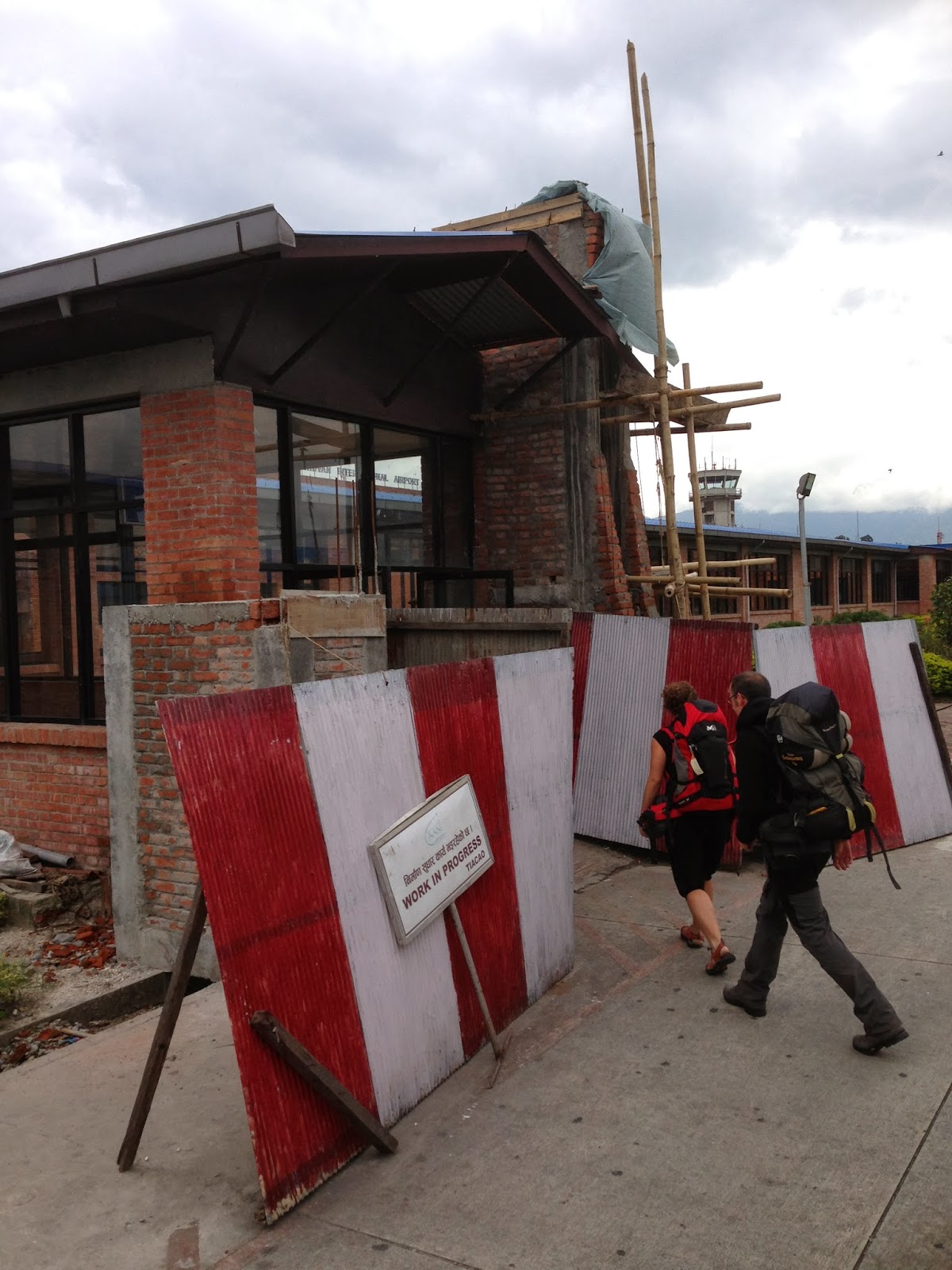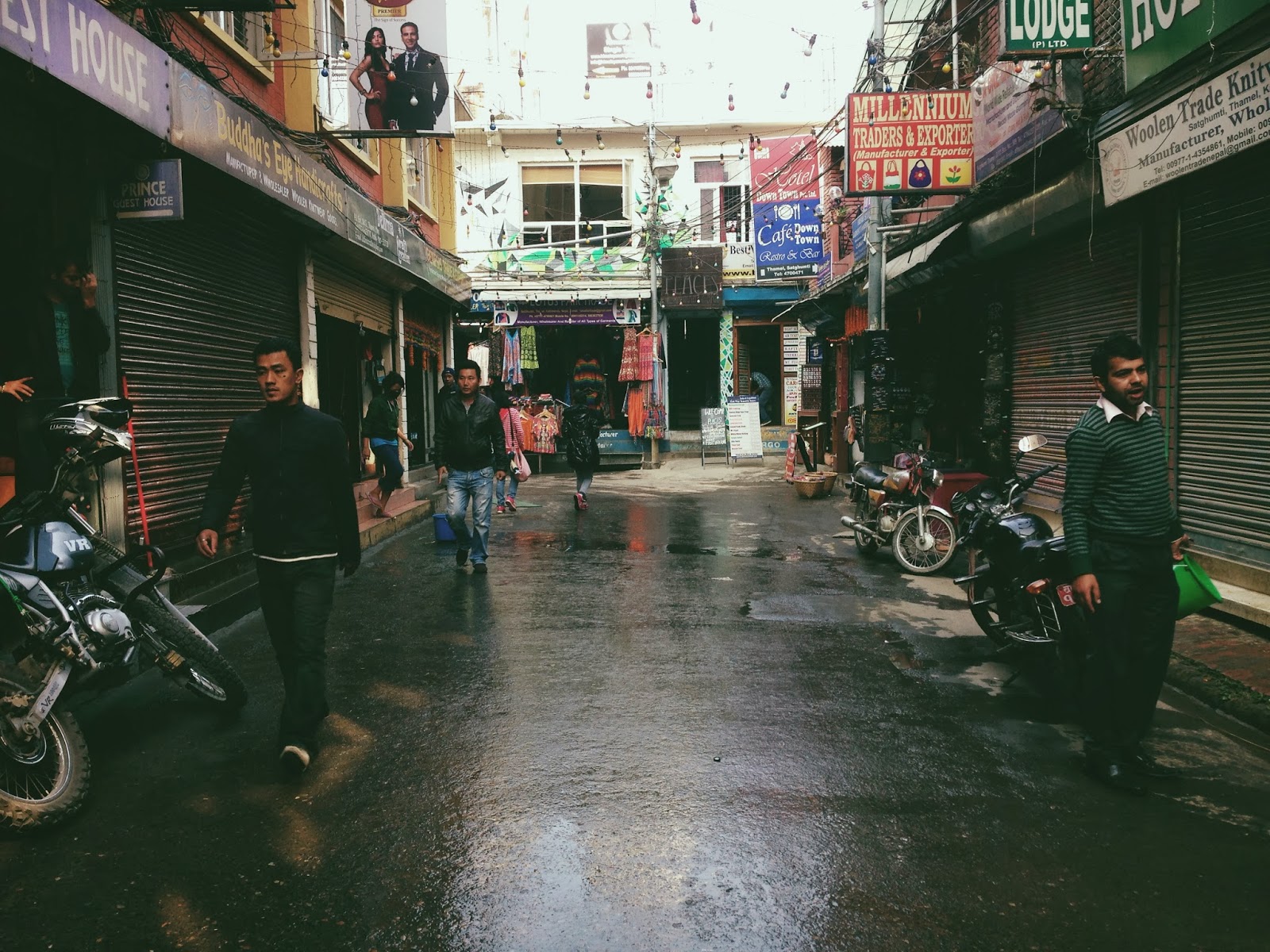The Stupa at Boudhanath
An essential preface:
The next four posts will cover various aspects of life in Kathmandu. I can sadly only base this advice on my life in Kathmandu - daily volunteering for three months, based in Thamel, with very few chances to visit other areas of beautiful Nepal before my visa expired.
The content is therefore detailed, expanding beyond what one finds in most guidebooks and aimed at people who plan on staying in Kathmandu (specifically Thamel) for an extended period of time while undertaking daily work. It's also written as a reader's guide, with no nostalgic tagents that offer my opinion of the place: nobody wants to read a vacation essay, right? If you're planning on heading to Kathmandu, I hope you find these posts useful. Enjoy.
Arrival and Accommodation
Arrival into Kathmandu’s Tribhuvan International
Airport is impressive in a scenic sense. If you’re lucky, you’ll catch a view
of the distant Langtang mountain range before descending past the green, cloudy
hills of Kathmandu Valley. After landing, you’ll be herded onto a
less-than-impressive shuttle bus – even if your plane has landed ten metres
from the airport entrance, as mine did. If you are unfamiliar with the
Indian/Nepali way of doing things, don’t question the logic; just get on the
bus.
Hasty phone shot of the shuttle bus
Tribhuvan International Airport: a 'work in progress.'
Once inside the airport, stop: visa time. You can take
30, 60 or 90 days, and can extend a 90 day visa to an upper limit of 150 days
at an immigration office. To save yourself a grand total of three minutes, you
can do your visa work in your home country via the Nepalese embassy. It
probably isn’t worth the hassle, expense and Nepali levels of bureaucratic and
administrative chaos for the extra few minutes it’ll save you – baggage reclaim
will eat that up. Those who hold Indian nationality do not require a visa.
Stroll freely through the electronic security gates that aren’t switched on and
move quietly past the snoozing security guards. Grab your stuff and walk once
more past nonchalant security and a broken bag scanner. Kathmandu is a place
where people will want to sell you things because you are a tourist. This will
begin before you’ve even left the airport.
Prepare yourself for some next level security.
They’ll shout at you from the taxi and hotel desk to
engage their services. No. Smile and continue, there’s a taxi rank outside. If
you’ve landed at Tribhuvan airport, you probably want to go to Thamel, or
possibly Patan. Don’t pay more than 500 rupees for the privilege. This is still
a slightly inflated rate, but airport taxi drivers have come to expect more due
to the tendency of their clientele to not yet be familiar with the currency.
(It’s 160 Nepalese Rupees to the British pound at the time of writing – but
cost of living is very low in Nepal. Taxis are also priced per ride, not per
person). Of course, you won’t have any Nepalese Rupees because you cannot
obtain them from outside of Nepal. Change up a tenner or ten US/CAN/AUS bucks
at the airport, and no more than that amount – you’ll only need to pay for the
cab and airport exchange rates are obscene.
Your first Nepalese taxi ride will be terrifying; more
so if you’ve never been to anywhere like Nepal, India or Southeast Asia (or on
London’s South Circular) before. Attempt to leave your body as your driver
hares the wrong way up three lanes of one-way traffic. Keep your head, arms and
legs inside the vehicle at all times.
My first Nepali taxi ride
He will screech to a halt in the first block of Thamel
(if it was Thamel you were heading for, maybe even if you hadn’t wanted to go
there). If you’ve already booked a residence, try and get him to drive to this
location. If not, you’re likely to be chucked out at the doors of somewhere
like (for those in Thamel) Student Guest House, Marco Polo Guest House, or a
strip club. If you’re arriving in summer, the smell will be memorable. Try to
leave the smallest environmental dent possible while in Kathmandu – use canvas
shoppers, re-fill your water from coolers and avoid packaged food.
Rooftop view of the outer limit of Thamel
If you’ve not already booked a place to stay, you have
many options. Student Guest House is generally clean, the staff range from
psychotic to very friendly and room 310 has an excellent bathroom. (Avoid 309,
the mould grows an inch per day). I’ve not been to Marco Polo, which is next
door; but I can assume it is much the same. Beware the early curfews – apparently,
locking female guests out on the street in Thamel’s red light district at 11pm
is acceptable behaviour for many hostel staff. Kathmandu is currently operating
under a 12 midnight curfew regardless; all establishments bar one vile and
seedy club will shut before 1am.
The main road bypassing Thamel during a motor vehicle ban
Hotel Northfield, further down the road, has a
friendly night porter (call him Baji and be sure to tip him for his troubles)
who won’t lock you out. However, Hotel Northfield does have cockroaches,
bedbugs, and tourists from the PRC. It’s your call. If you’re at Student Guest
House, make friends with young Ram Lama, who is most likely to be on night door
duty. He lives on the front desk and wears a red t-shirt almost every day.
Thamel from street level
A note about night porters: they often as part of the
job sleep on makeshift beds close to the front entrance of their given hotels
and will usually be woken up by drunken tourists at all hours of the night. Be
sure to chat to them daily, ask how they are, and tip them/bring them snacks
when possible – their job is hard, but shouldn’t have to be thankless.
There are countless hotels and hostels of varying
quality throughout Thamel – be sure to ask for ‘hotels in China town’ – this area
has accommodation catering mostly to Chinese and Japanese tourists (which is ideal if you are a Chinese or Japanese tourist and would like services in your first language) but is well
worth checking out regardless of where you're from.
Next. You’ve chucked your bags on the floor and are
about to flop your plane-cramped body onto the bed. Easy now, those mattresses
are firm. If you are one of those
‘types’ who travels to ‘developing’ countries in Birks/Jesus creepers and
paisley drop-crotch clown pants in an effort to look ‘super ethnic and local’,
please take a moment to re-evaluate your life before heading outside and
perhaps for the remainder of your time in Kathmandu. There is no sight more ridiculous
than tourists dressed like desert clowns. People who dress like this are also
likely to have a harder time in the city – you will experience more intense
hard-sell from street vendors and will not be looked upon favourably by bar,
restaurant and establishment owners due to the deep-rooted perception of hippie
types being difficult and cheap.
Many tourists insist on dressing like MC Hammer when visiting Nepal
You may also see foreign tourists dressed as 'Sadhu' - Hindu holy men. They appear to be unaware of the fact that Snapchatting while getting beers and pizza with your 'Sadhu bro' negates the prerogative of the asetic lifestyle to which an actual Sadhu will adhere. Nope, these guys just appropriate holy practices for lols. Avoid them.
A few words on Thamel street vendors. They will try
and sell you everything and anything. If you don’t want or need what they’re
selling, smile and politely refuse, and keep walking. Some will be fairly
conspicuous in their attempts to try and sell you hash – don’t bite. There’s
always the possibility that it’s a sting to bleed money out of stupid tourists.
More often than not, it’ll just be the stuff the locals call ‘crappy valley
hash.’ Don’t waste your time.
Find a money changer in Thamel – the one opposite
Student Guest House and Marco Polo is excellent and gives great rates. If
you’re paying for all your meals, you can expect to burn through 50-70 British
pounds in a week, living well. Eat where and how the locals eat and it’ll be
about half that amount. If you have to pay for transport, it’ll be a bit more.
Expect to pay for the occasional taxi journey (150 to 200 NRs one way to the
Monkey Temple, for example) and the initial stock-up when you arrive.
That's all for the overview of your first few hours in the city. No matter how many reviews you read, your first day here will be chaotic, memorable and overwhelming; all part of the joy of travel. My next post will cover stocking up on supplies if you're planning on a slightly longer stay, as well as the 'water situation.' This will be followed by the all important food (and good coffee) post. Bye now.
When the madness of Kathmandu becomes too much, head to the top of the Monkey Temple for a mint ice tea and a stunning sunset. It serves as a reminder of how beautiful this hectic city can be.
That's all for the overview of your first few hours in the city. No matter how many reviews you read, your first day here will be chaotic, memorable and overwhelming; all part of the joy of travel. My next post will cover stocking up on supplies if you're planning on a slightly longer stay, as well as the 'water situation.' This will be followed by the all important food (and good coffee) post. Bye now.






















Nepal is awesome country. I visit one time in Nepal . i want to visit again.
ReplyDelete